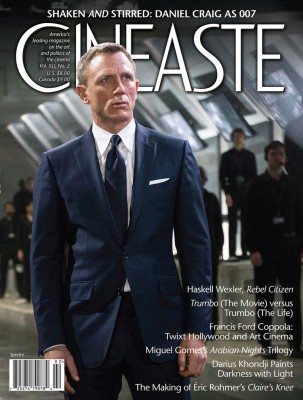
The latest edition of the independent quarterly Cineaste (Spring, 2016), the respected American magazine devoted to the world of movies, has a detailed article on the latest Bond movie Spectre, and seeks to pin down and critically appraise the nature of Daniel Craig’s Twenty-First Century 007.
The article, penned by film expert Jonathan Murray, notes how, 54 years and 24 official films later – and despite the combined best efforts of the likes of Mike Myers, Jason Bourne and others – James Bond remains the hardest-bitten survivor in cinema history.
Moreover, according to Murray: ‘Whatever else it may be… Daniel Craig’s four-film tenure as 007 looks like mission accomplished in commercial and, to an extent, critical terms alike’. He notes that Casino Royale (2006) and Skyfall (2012) are among the most acclaimed entries in the Bond franchise, and the latter film’s five Oscar nominations nearly doubled the entire series’ running tally to that point.
Murray goes on to offer plenty of high-brow discussion of Spectre, its position in the franchise and, in particular, its relation to the Craig ‘quartet’ of 007 adventures. Plenty of interesting observations emerge. He notes, for example, that over the four-film cycle of the Craig movies, a sense of gradual ‘reconstruction’ of the franchise has been in evidence, with the slow reintroduction of some of the key backroom team in the form of new actors in the roles: Leiter, Tanner, Moneypenny, ‘Q’, and even a new ‘M’. Similarly, with the four Craig films’ precredits and main-title sequences, and a new emphasis on the proper development of Bond’s character in the main plotlines, viewers have again witnessed the ongoing reconstruction of the franchise, with new ‘revelations’ about Bond’s character, life and background. In fact, character ‘revelation’ remains to the fore in Spectre.
Indeed, the Craig quartet of Bond movies in general repeatedly foreground an emphasis on ‘character’, the role of the past in the formation of character, and the many shades of grey associated with complex psychology and backstory: it is not just Bond’s character that gets a backstory, but this is also the case with Vesper, Camille, Dominic Greene, Severine, Silva, to name just a few – not to mention Bond’s boss ‘M’ (as played by Dench). And then there is Blofeld, who is reintroduced into the series in Spectre and, as Murray notes, is played as ‘an adult manifestation of a psychotic teenager who killed his own father in a fit of jealous adolescent rage’. Fascinating stuff!
Intriguingly, towards the end of his article, Murray joins some other critics in speculating on the possible significance of the music Bond encounters in the car he steals from 009: Sinatra’s ‘New York, New York’ – which may well capture the current situation of Craig’s tenure as Bond: ‘Start spreading the news/I’m leaving today’. It’s an interesting point, but we’ll just have to wait and see…
Murray also offers a number of other interesting, if controversial, views on the Craig films. It’s a great read. If you like your coverage of all things Bond to be thoughtful, scholarly and slightly ‘deeper’ than usual, then this is the article for you.
Cineaste, Vol. XLI, no. 2 (Spring, 2016) is on sale now. See: www.cineaste.com

